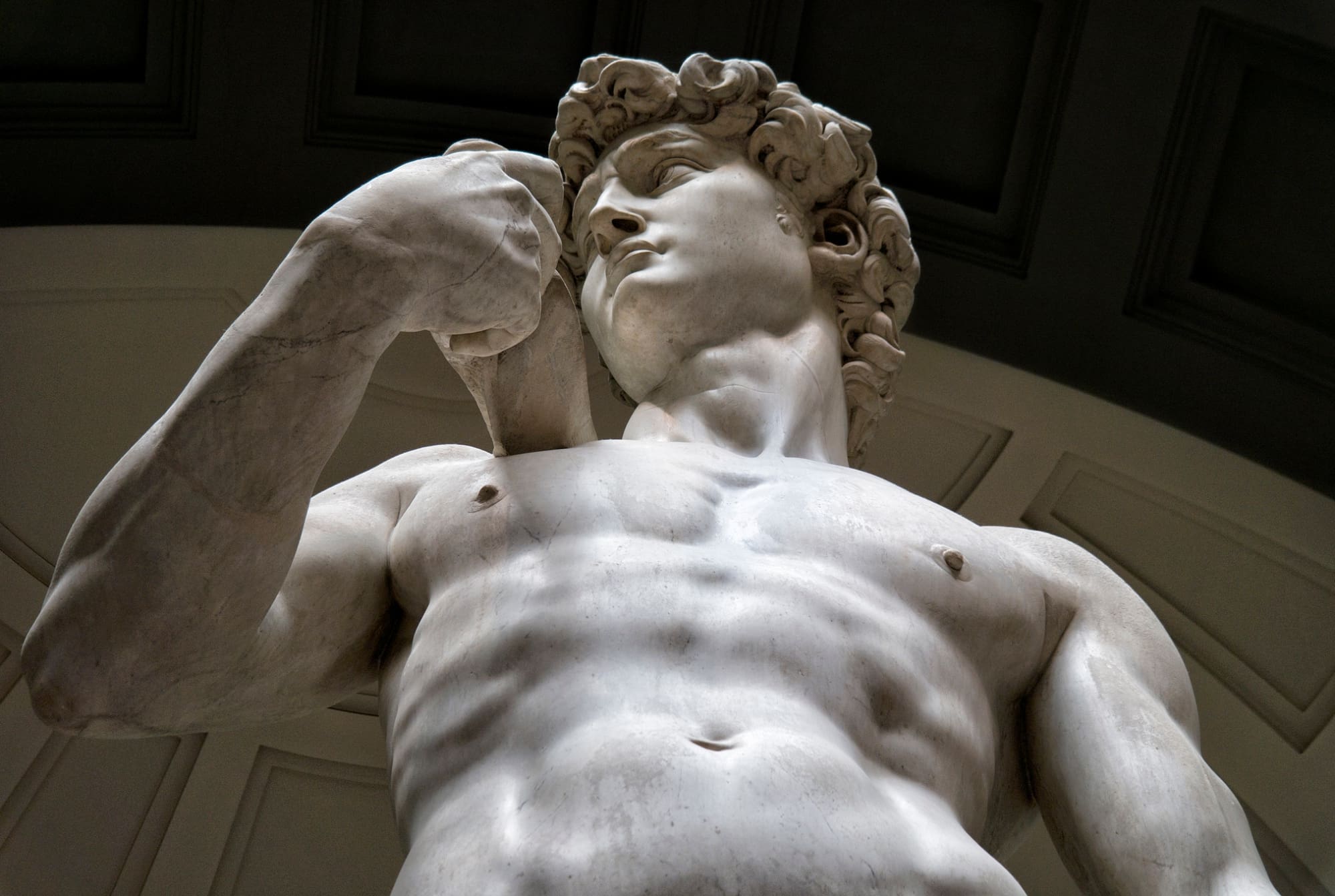
Michelangelo's David stands as one of the most iconic sculptures in art history, embodying the pinnacle of Renaissance sculpture and showcasing Michelangelo's unparalleled skill in capturing human beauty and emotion in marble. This masterpiece, created between 1501 and 1504, has fascinated art lovers and historians alike for centuries. Michelangelo's David isn't just a statue; it's a symbol of strength, youthful beauty, and the artistic spirit of the Renaissance. In this introduction, we'll unveil 20 captivating facts about this magnificent work of art. From its colossal size to the political symbolism it carried in Florence, each fact will deepen your appreciation and understanding of this unparalleled sculpture. Get ready to be amazed by the stories and secrets that have made Michelangelo's David a subject of admiration and study across the world.
Michelangelo's David stands as one of the most iconic sculptures in the history of art, embodying the beauty of the Renaissance and the mastery of its creator, Michelangelo Buonarroti. This masterpiece has captivated audiences for centuries, not just as a symbol of Florence but as a representation of human beauty and strength. Let's delve into some fascinating facts about this remarkable sculpture.
The Creation of David
Michelangelo was only 26 years old when he began working on David in 1501. He completed the colossal statue in 1504, showcasing not just his unparalleled skill as a sculptor but also his deep understanding of human anatomy and form.
-
Commissioned by the Opera del Duomo for the Cathedral of Florence, the statue was originally intended to be one of a series of prophets to be positioned along the roofline of the east end of Florence Cathedral. However, its placement was later changed.
-
Carved from a single block of marble, the statue stands at a towering 17 feet tall, making it a marvel of scale and beauty. The marble used was sourced from the famed quarries of Carrara in Northern Italy.
-
Michelangelo chose a block of marble that had been previously worked on and abandoned by other artists. This block was known as "the Giant," due to its massive size and the challenge it presented.
Symbolism and Interpretation
David is not just a testament to Michelangelo's skill but also a symbol loaded with meaning, reflecting the political and cultural environment of Florence at the time.
-
David represents the biblical hero who defeated Goliath, symbolizing the triumph of good over evil. This was particularly resonant for the Republic of Florence, as it saw itself as a small but righteous power.
-
Unlike previous representations of David, which portrayed the aftermath of the battle, Michelangelo's David is depicted before the fight, tense and ready for action. This anticipation of movement is one of the statue's most striking features.
-
The statue's gaze, often interpreted as a look of warning, reflects the political climate of Florence, vigilant against larger, surrounding states.
Location and Impact
Since its completion, David has had a significant impact on art and culture, becoming a symbol of both the city of Florence and the Renaissance period.
-
Originally placed in the Piazza della Signoria in 1504, the statue was moved to the Galleria dell'Accademia in Florence in 1873 to protect it from damage. A replica now stands in its original location.
-
The placement of David in the Piazza della Signoria was a political statement, symbolizing the defense of civil liberties embodied by the Florentine Republic.
-
The impact of David on the Renaissance and beyond cannot be overstated. It has inspired countless artists and has become a symbol of humanist ideals.
Conservation Challenges
Maintaining and preserving David has presented unique challenges over the centuries, given its size, age, and the fragility of marble.
-
Cracks in the statue's legs and ankles have raised concerns about its stability. These are believed to be caused by the weight of the statue and the uneven distribution of that weight.
-
In preparation for the statue's 500th anniversary in 2004, a major cleaning and restoration project was undertaken. This was the first thorough cleaning the statue had undergone since 1843.
-
Efforts to preserve David also include monitoring the statue with digital technology, allowing conservators to detect any potential issues early.
David in Popular Culture
Over the years, Michelangelo's David has transcended its historical and artistic origins to become a cultural icon.
-
Replicas of David can be found all over the world, from full-size copies in museums to miniature versions in souvenir shops. This widespread reproduction speaks to the statue's universal appeal.
-
The image of David has been used in various forms of media, including films, advertisements, and even political campaigns, often symbolizing strength and beauty.
-
Controversies have occasionally arisen over the nudity of the statue, reflecting changing societal attitudes towards art and obscenity.
Technical Marvels of the Sculpture
The technical aspects of David reveal Michelangelo's innovative approach to sculpture and his mastery of the medium.
-
The contrapposto stance of the statue, where the weight is shifted onto one leg, was revolutionary at the time and contributed to the dynamic quality of the sculpture.
-
Michelangelo's detailed work on the veins and muscles of David showcases his deep knowledge of human anatomy, which he studied through dissection.
-
The precision with which Michelangelo captured the human form in marble demonstrates not just technical skill but a profound understanding of the material's possibilities and limitations.
-
Despite the statue's massive size, Michelangelo achieved a level of detail and realism that remains unparalleled, making David not just a feat of engineering but a work of art that continues to inspire awe and admiration.
-
The choice to depict David with an oversized head and hands has been the subject of much debate among art historians. Some suggest it was intended for viewers looking up at the statue from below, while others believe it was a deliberate stylistic choice to emphasize the theme of intellect and strength.
A Final Brushstroke on Michelangelo's Masterpiece
Michelangelo's David isn't just a statue. It's a symbol of strength, beauty, and human potential. From its towering height to the intricate details carved with unparalleled skill, every aspect tells a story of artistic dedication and Renaissance ideals. Whether you're marveling at its history, the technical prowess it took to create, or the controversies it sparked, David remains a testament to Michelangelo's genius. Standing before it, viewers can't help but feel a connection to the past, a sense of awe at what human hands can achieve. So, next time you find yourself wandering through Florence, or simply dreaming of its artistic treasures, remember the legacy of David. It's more than marble; it's a milestone in human creativity.
Was this page helpful?
Our commitment to delivering trustworthy and engaging content is at the heart of what we do. Each fact on our site is contributed by real users like you, bringing a wealth of diverse insights and information. To ensure the highest standards of accuracy and reliability, our dedicated editors meticulously review each submission. This process guarantees that the facts we share are not only fascinating but also credible. Trust in our commitment to quality and authenticity as you explore and learn with us.


